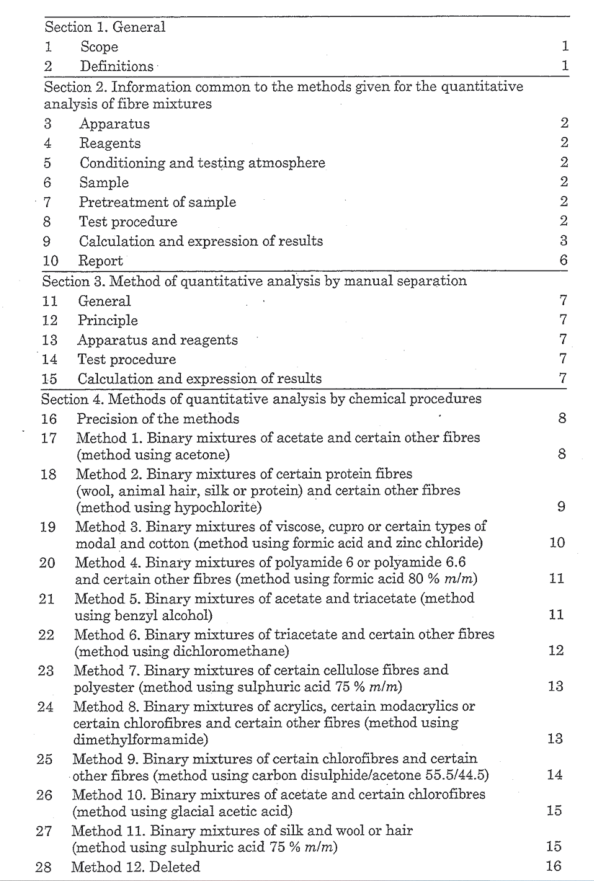AS 2001.7 pdf download – RECONFIRMATION OF AS 2001.7—2005 Methods of test for textiles Method 7: Quantitative analysis of fibre mixtures (BS 4407:1988, MOD)

AS 2001.7 pdf download – RECONFIRMATION OF AS 2001.7—2005 Methods of test for textiles Method 7: Quantitative analysis of fibre mixtures (BS 4407:1988, MOD)
16 Precision of the methods
The precision indicated in individual methods
relates to the reproducibility. Reproducibility refersto the reliability,i.e.the closeness of agreementbetween experimental values obtained by operatorsin different laboratories, or at different times usingthe same method and obtaining individual resultson specimens of an identical homogeneous mixture.The reproducibility is expressed by confdence limitsof the results for a confidence level of 95 %.
By this is meant that the difference between tworesults in a series of analyses made in differentlaboratories would, given a normal and correctapplication of the method to an identical andhomogeneous mixture, be exceeded only in fivecases out of a hundred.
To determine the precision of the analysis of a ternary mixture the values indicated in the methodsfor the analysis of binary mixtures which have beenused to analyse the ternary mixture are applied inthe usual way.
Given that in the four variants (see Appendix A) ofthe quantitative chemical analysis of ternary mixtures, provision is made for two dissolutions(using two separate specimens for the first threevariants and a single specimen for the fourthvariant), and assuming Eand E2 denote theprecision of the two methods for analysing binarymixtures, the precision of the results for eachcomponent is shown in Table 1.
17 Method 1.Binary mixtures ofacetate and certain other fibres(method using acetone)
17.1 General
This method is applicable,after removal of
non-fibrous matter, to binary mixtures of acetatewith cotton,wool, animal hair, silk, protein,
polyamide, polyester, acrylic, flax, true hemp, jute,abaca, alfa, coir, broom, ramie, sisal, modal, cuproand viscose.It is not applicable to mixtures
containing modacrylic.In no circumstances is themethod applicable to acetate which has been
deacetylated on the surface.
17.2 Principle
The acetate is dissolved from a known dry mass ofthe mixture using acetone.The residue is collected,washed, dried, and weighed.Its mass is expressedas a percentage of the dry mass of the mixture.Thepercentage of acetate is found by difference.
17.3 Apparatus and reagents
The following apparatus and reagents, togetherwith those specified in clauses 3 and 4, are required.17.3.1 Apparatus
17.3.1.1 Conical flask, capacity 250 mL, withground glass stopper.
17.3.2 Reagent
17.3.2.1Acetone complying with BS 509-1.17.4 Test procedure
Follow the procedure described in 8.2 and proceedas follows.
To the specimen contained in the stoppered conicalflask (17.3.1.1)add 100 mLof acetone (17.3.2.1) pergram of specimen, insert the stopper, shake theflask,and stand it for 30 min at room temperatureshaking it occasionally. Decant the liquid throughthe weighed filter crucible retaining the fibres in theflask. Repeat the treatment twice more (makingthree extractions in all) but for periods of 15 minonly, so that the total time of treatment in acetoneis i h.Wash the residue into the filter crucible withacetone, and drain with suction.Refill the cruciblewith acetone and allow it to drain under gravity.Finally, drain the crucible with suction, dry thecrucible and residue,and cool and weigh them(see 8.1.3,8.1.4 and 8.1.5).
17.5 Calculation and expression of resultsCalculate the results as described in 9.1.The valueof d is 1.00.









